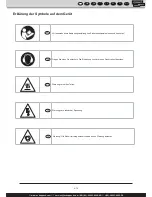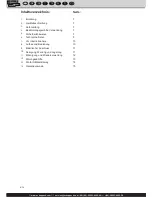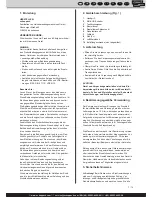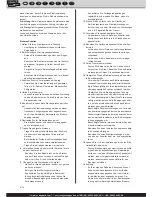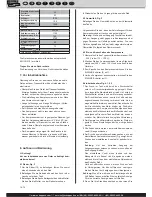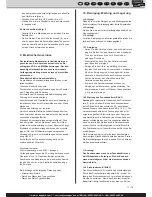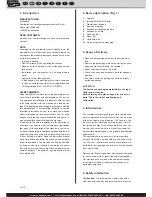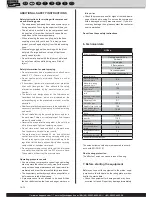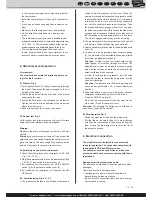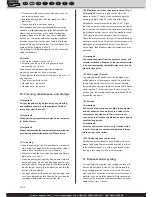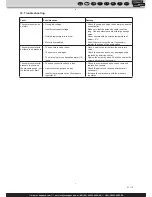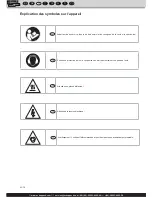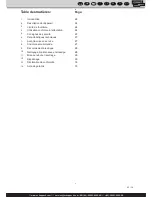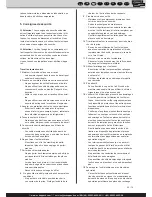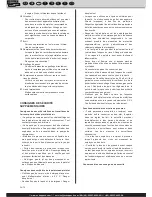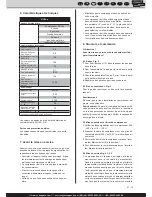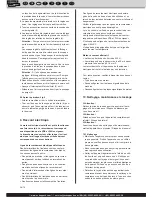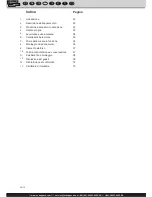
www.scheppach.com /
+(49)-08223-4002-99 /
+(49)-08223-4002-58
third parties.
•
Check the pressure vessel for signs of rust and dama-
ge each time before using. Do not use the compressor
with a damaged or rusty pressure vessel. If you dis-
cover any damage, then please contact the customer
service workshop.
Do not lose these safety instructions
6. Technical data
HC24 o
Extent of delivery
Compressor HC24 o
2 wheels
2 axle pins
2 flat washers
2 nuts
1 accessory pack
Operating Instructions
Technical data
Maximum operating
pressure, bars
9,0
Maximum working
pressure, bars
9,0
Free air displacement
(FAD) l/min.
130
Air replacement, (PD)
l/min.
190
Pressure vessel capa-
city (in liters)
24
Operating mode
S1
Protection type
IP20
Weight of the unit in kg
13,5
Max. altitude (above
mean sea level) m
1000
Drive
Motor in V/Hz
230/50
Input W
1100
Output W
750
Speed 1/min.
3750
Sound power level
L
WA
dB
95
Sound pressure level
L
PA
dB
73
Uncertainty K
WA/PA
dB
3
Subject to technical changes.
The noise emission values were measured in accord-
ance with EN ISO 2151.
Wear hearing protection.
The effects of noise can cause a loss of hearing.
7. Before starting the equipment
Before you connect the equipment to the mains supp-
ly make sure that the data on the rating plate are iden-
tical to the mains data.
•
Check the equipment for damage which may have
occurred in transit. Report any damage immediately
ADDITIONAL SAFETY INSTRUCTIONS
Safety instructions for working with compressed
air and blasting guns
• The compressor pump and lines can become very hot
during operation. Touching these parts will burn you.
• The air which is sucked in by the compressor must
be kept free of impurities that could cause fires or
explosions in the compressor pump.
• When releasing the hose coupling, hold the hose
coupling piece with your hand. This way, you can
protect yourself against injury from the rebounding
hose.
• Wear safety goggles when working with the blow-
out pistol. Foreign bodies or blown off parts can
easily cause injuries.
• Do not blow at people with the blow-out pistol and
do not clean clothes while being worn. Risk of
injury!
Safety information for paint spraying
• Do not process any paints or solvents with a flash point
below 55° C. There is a risk of explosion!
• Do not heat up paints or solvents. There is a risk of
explosion!
• If hazardous liquids are processed, wear protective
filter units (face guards). Also, adhere to the safety
information provided by the manufacturers of such
liquids.
• The details and designations of the Ordinance on
Hazardous Substances, which are displayed on the
outer packaging of the processed material, must be
observed.
• Additional protective measures are to be undertaken if
necessary, particularly the wearing of suitable clothing
and masks.
• Do not smoke during the spraying process and/or in
the work area. There is a risk of explosion! Paint vapors
are easily combustible.
• Never set up or operate the equipment in the vicinity of
a fire place, open lights or sparking machines.
• Do not store or eat food and drink in the work area.
Paint vapors are harmful to your health.
• The work area must exceed 30 m3 and sufficient
ventilation must be ensured during spraying and drying.
Do not spray against the wind. Always adhere to the
regulations of the local police authority when spraying
combustible or hazardous materials.
• Do not process media such as white spirit, butyl alcohol
and methylene chloride with the PVC pressure hose.
These media will destroy the pressure hose.
Operating pressure vessels
•
You must keep your pressure vessel in good working
order, operate the vessel correctly, monitor the vessel,
carry out necessary maintenance and repair work im-
mediately and meet the relevant safety precautions.
•
The supervisory authority may enforce essential con-
trol measures in individual cases.
•
A pressure vessel is not allowed to be used if it has
faults or deficiencies that can endanger workers or
18 / 76
FR
IT
CK
DE
SK
PL
HU
GB


